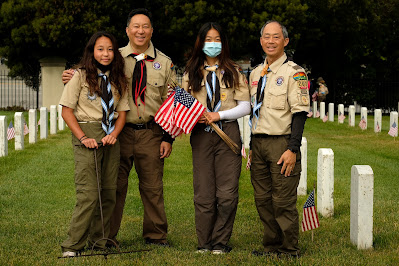There is one certainty when photographing community events, and that is you never know when a better image may come along. Unlike editorial photography where there is a specific goal, photographs submitted from events may not have a specific person or thing to highlight, so it is up to the photographer to make an image that best represents the "vibe" of the gathering. This weekend there were two different events, and each served two different purposes.
The lead photo was from the annual flag planting ceremony at the Golden Gate National Cemetery in San Bruno. It had been cancelled last year due to the pandemic, and many still took the precaution of wearing a mask. Most of the participants were Scouts for the area, and now that young women are becoming more common in local troops, I really wanted them to be represented.
Lens Choice: Normally I would bring my "big guns" to the event, and when I was shooting Nikons, my kit composed of a three bodies: One with a 24-70 2.8 Nikkor on a D600 (full frame) body, a 70-200 2.8 Nikkor on an APS body, and a Sigma 150-600 lens on another APS body, if I remember correctly. I always carried the Sigma, as one time I actually needed its long focal length to do some major visual compression. I don't know how much all this stuff weighed, but I do know I was always exhausted when I was done.
This year, I had an epiphany: Since I was shooting outdoors, I didn't need to bring those F 2.8 lenses, which are quite dense. My Fuji kit consisted of a X-T1 with an 18-55 F 2.8-4.0, the Fuji X-mount "kit lens". My X-T2 body was fitted with a 55-200 F3.5-4.8 lens. I still carried a third camera, a Nikon D7200 riding on a 200-500 F 5.6 Nikkor, the lens that replaced my old Sigma. In terms of perspective, I had a focal length for any situation, and lightened my load by a considerable amount.
Directing My Subjects: For the record, I did some directing on my two young subjects. This was limited to having the "flag lady" kneel when she planted the flag, and had her hold the unused flags a little higher for better visibility. I'm not pretending that I didn't have any contact with the subjects, which is a basic tenet of ethical photojournalism, but to my defense, they were actually installing the flags, so I wasn't actually influencing what they were already doing.
Proud Fathers: I worked with these two Scouts for quite some time, so before long their fathers drop by to see what was going on. After introducing myself, I asked if they'd like to have a photo with their daughters, and they were delighted. Think about, it only took a minute or two to make the shot, pretty much exactly where they were already standing. I must say that the Goddess of Lighting was watching out for me, because all of the photos taken in the series had the soft lighting of a cloudy-bright day, so there is plenty of form-defining shadows in their faces. It doesn't get any easier than that.


















